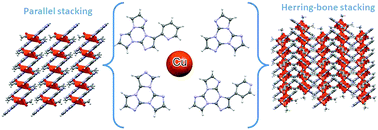Regulation of π⋯π stacking interactions between triimidazole luminophores and comprehensive emission quenching by coordination to Cu(ii)†
Abstract
Eight Cu(II) coordination compounds with cyclic triimidazole, triimidazo[1,2-a:1′,2′-c:1′′,2′′-e][1,3,5]-triazine (L1), its positional isomer, triimidazo[1,2-a:1′,2′-c:1′′,5′′-e][1,3,5]-triazine (L2), and two pyridine derivatives of L1, 3-(pyridin-2-yl)triimidazo[1,2-a:1′,2′-c:1′′,2′′-e][1,3,5]triazine (L3) and 3-(pyridin-4-yl)triimidazo[1,2-a:1′,2′-c:1′′,2′′-e][1,3,5]triazine (L4) are reported. All compounds represent neutral Cu(II) discrete complexes or coordination polymers comprising luminophore triimidazole molecules and charge-compensated anions. Starting from copper(II) acetate monohydrate with the paddle-wheel geometry, two binuclear complexes [Cu2(CH3COO)4(L1)2] (1) and [Cu2(CH3COO)4(L3)2] (2), a mixed-dimensional 0D/1D coordination compound {[Cu2(CH3COO)4(L2)]2[Cu2(CH3COO)4(H2O)(L2)]·2(H2O)}n (3), all with binuclear paddle-wheel [Cu2(CO2)4] secondary building units, and a mononuclear complex [Cu(CH3COO)2(L2)2] (4) with square-planar N2O2 Cu(II) coordination, were obtained. Starting from copper(II) nitrate trihydrate, three mononuclear complexes [Cu(NO3)2(L2)4]·2CH3CN (5), [Cu(NO3)2(L2)4]·1.5(dmf) (6), and [Cu(NO3)2(H2O)2(L4)2]·2H2O (7) with Cu(II) distorted octahedral N4O2 and N2O4 coordination cores, and 1D coordination polymer [Cu(NO3)2(L3)]n (8) with the distorted square pyramidal N2O3 Cu(II) coordination geometry were obtained. In the mono- and binuclear complexes, luminophores L1–L4 coordinate as monodentate terminal ligands. In the coordination chain 3 the L2 ligand acts as a bidentate-bridging exo-ligand, while in 8 the L3 ligand acts as a bidentate-chelate one, and the structure extension to 1D is achieved via the bridging nitrate-anions. The compromise between the hydrogen bonds and π⋯π stacking interactions defines the stacking patterns of bulky luminophores coordinated to the metal center that vary from the dimeric associates to the infinite 2D motifs with the different overlapping areas of the stacking ligands. The strong aggregation-induced emission demonstrated by pure luminophores was nearly quenched in the reported Cu(II) coordination compounds in the solid state.



 Please wait while we load your content...
Please wait while we load your content...